Prepare Final Accounts for Sole Traders and Partnerships Report
VerifiedAdded on 2021/01/01
|20
|4301
|268
Report
AI Summary
This report provides a comprehensive overview of final accounts for sole traders and partnerships. It covers the reasons for preparing final accounts, the processes involved, and the limitations encountered. The report delves into the methods of constructing accounts from incomplete records, including markup and margin, control accounts, and the accounting equation. It addresses the imbalances resulting from incorrect double entries and the challenges posed by insufficient or inconsistent data. The report further explores the elements of final accounts for sole traders, including the statement of profit and loss and the statement of financial position. It also covers the key components of partnership agreements and accounts, including the statement of profit or loss appropriation account, partner capital and current accounts, and the calculation of closing balances and preparation of the statement of financial position. The report includes calculations of opening and closing capital, cash/bank balances, and sales and purchase ledger control accounts. Overall, the report provides a detailed analysis of the accounting principles and practices related to the preparation of final accounts for sole traders and partnerships.
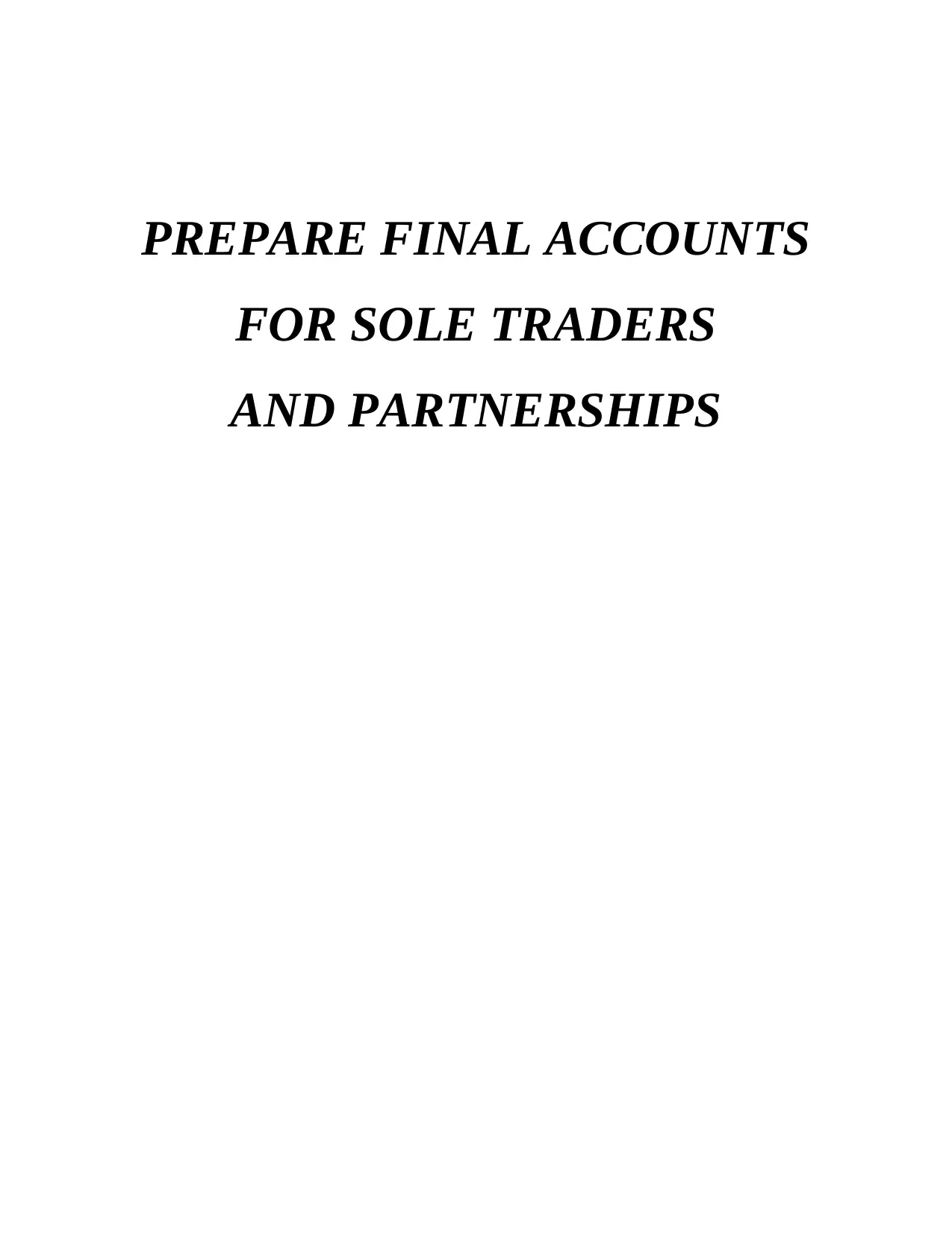
PREPARE FINAL ACCOUNTS
FOR SOLE TRADERS
AND PARTNERSHIPS
FOR SOLE TRADERS
AND PARTNERSHIPS
Paraphrase This Document
Need a fresh take? Get an instant paraphrase of this document with our AI Paraphraser
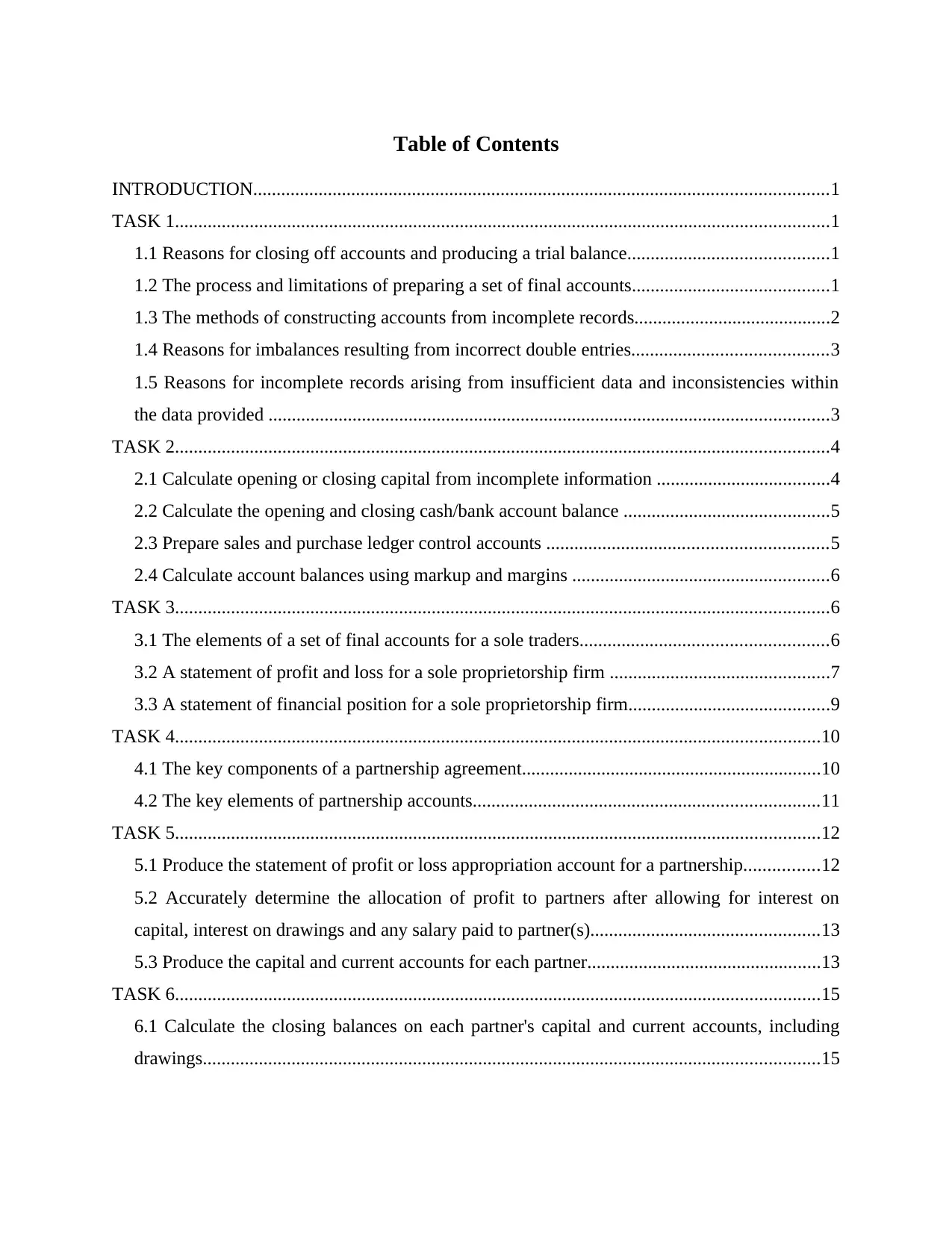
Table of Contents
INTRODUCTION...........................................................................................................................1
TASK 1............................................................................................................................................1
1.1 Reasons for closing off accounts and producing a trial balance...........................................1
1.2 The process and limitations of preparing a set of final accounts..........................................1
1.3 The methods of constructing accounts from incomplete records..........................................2
1.4 Reasons for imbalances resulting from incorrect double entries..........................................3
1.5 Reasons for incomplete records arising from insufficient data and inconsistencies within
the data provided ........................................................................................................................3
TASK 2............................................................................................................................................4
2.1 Calculate opening or closing capital from incomplete information .....................................4
2.2 Calculate the opening and closing cash/bank account balance ............................................5
2.3 Prepare sales and purchase ledger control accounts ............................................................5
2.4 Calculate account balances using markup and margins .......................................................6
TASK 3............................................................................................................................................6
3.1 The elements of a set of final accounts for a sole traders.....................................................6
3.2 A statement of profit and loss for a sole proprietorship firm ...............................................7
3.3 A statement of financial position for a sole proprietorship firm...........................................9
TASK 4..........................................................................................................................................10
4.1 The key components of a partnership agreement................................................................10
4.2 The key elements of partnership accounts..........................................................................11
TASK 5..........................................................................................................................................12
5.1 Produce the statement of profit or loss appropriation account for a partnership................12
5.2 Accurately determine the allocation of profit to partners after allowing for interest on
capital, interest on drawings and any salary paid to partner(s).................................................13
5.3 Produce the capital and current accounts for each partner..................................................13
TASK 6..........................................................................................................................................15
6.1 Calculate the closing balances on each partner's capital and current accounts, including
drawings....................................................................................................................................15
INTRODUCTION...........................................................................................................................1
TASK 1............................................................................................................................................1
1.1 Reasons for closing off accounts and producing a trial balance...........................................1
1.2 The process and limitations of preparing a set of final accounts..........................................1
1.3 The methods of constructing accounts from incomplete records..........................................2
1.4 Reasons for imbalances resulting from incorrect double entries..........................................3
1.5 Reasons for incomplete records arising from insufficient data and inconsistencies within
the data provided ........................................................................................................................3
TASK 2............................................................................................................................................4
2.1 Calculate opening or closing capital from incomplete information .....................................4
2.2 Calculate the opening and closing cash/bank account balance ............................................5
2.3 Prepare sales and purchase ledger control accounts ............................................................5
2.4 Calculate account balances using markup and margins .......................................................6
TASK 3............................................................................................................................................6
3.1 The elements of a set of final accounts for a sole traders.....................................................6
3.2 A statement of profit and loss for a sole proprietorship firm ...............................................7
3.3 A statement of financial position for a sole proprietorship firm...........................................9
TASK 4..........................................................................................................................................10
4.1 The key components of a partnership agreement................................................................10
4.2 The key elements of partnership accounts..........................................................................11
TASK 5..........................................................................................................................................12
5.1 Produce the statement of profit or loss appropriation account for a partnership................12
5.2 Accurately determine the allocation of profit to partners after allowing for interest on
capital, interest on drawings and any salary paid to partner(s).................................................13
5.3 Produce the capital and current accounts for each partner..................................................13
TASK 6..........................................................................................................................................15
6.1 Calculate the closing balances on each partner's capital and current accounts, including
drawings....................................................................................................................................15
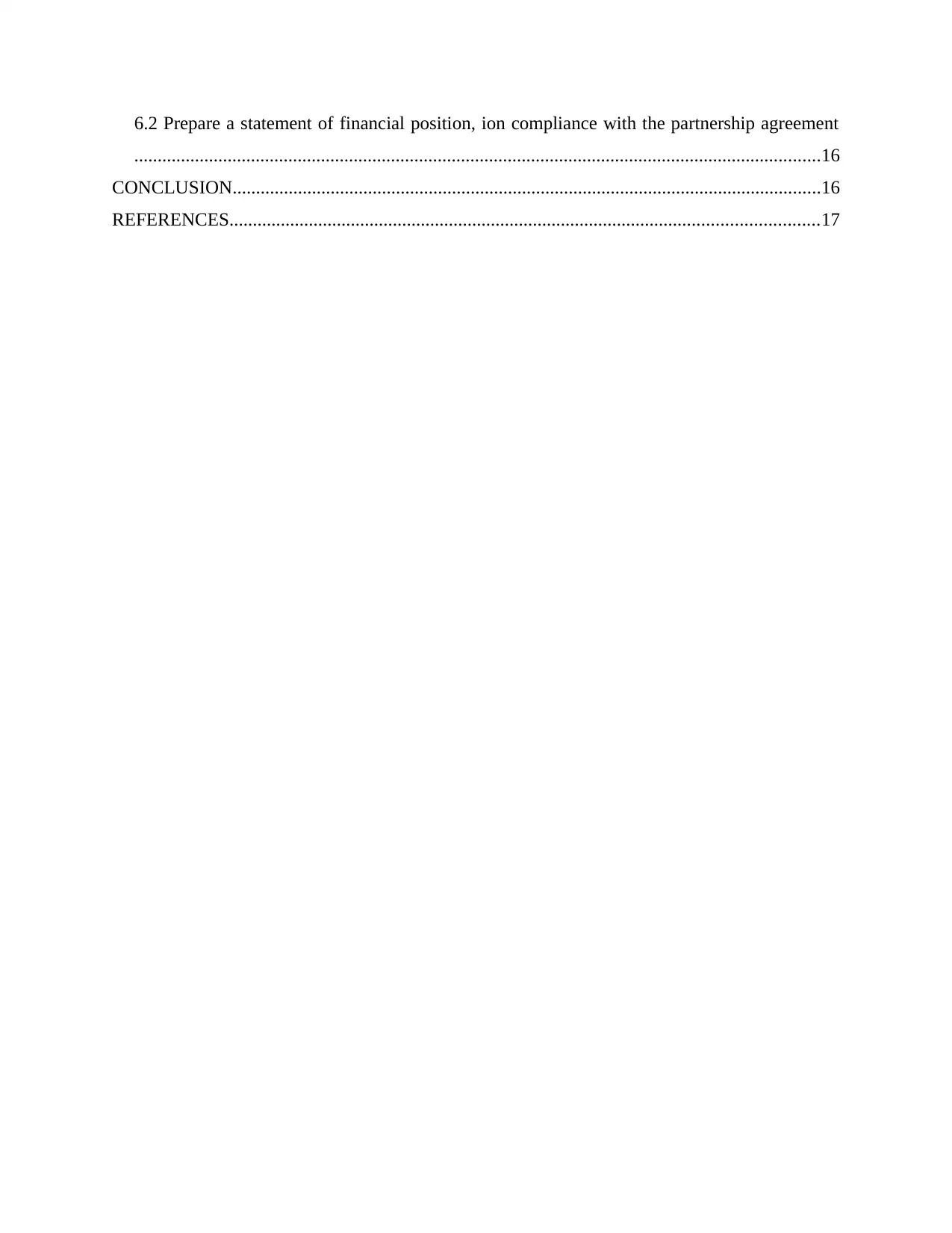
6.2 Prepare a statement of financial position, ion compliance with the partnership agreement
...................................................................................................................................................16
CONCLUSION..............................................................................................................................16
REFERENCES..............................................................................................................................17
...................................................................................................................................................16
CONCLUSION..............................................................................................................................16
REFERENCES..............................................................................................................................17
⊘ This is a preview!⊘
Do you want full access?
Subscribe today to unlock all pages.

Trusted by 1+ million students worldwide
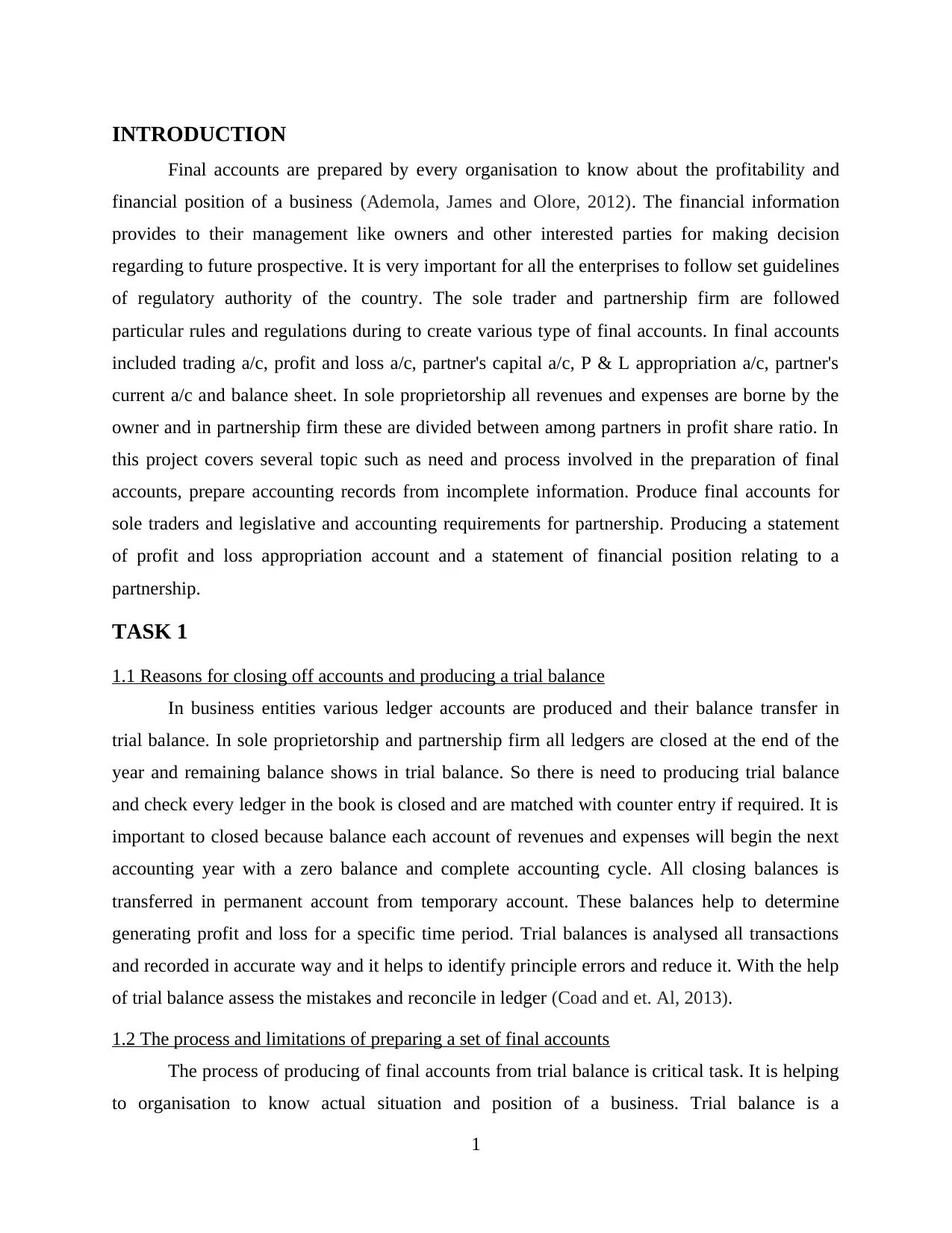
INTRODUCTION
Final accounts are prepared by every organisation to know about the profitability and
financial position of a business (Ademola, James and Olore, 2012). The financial information
provides to their management like owners and other interested parties for making decision
regarding to future prospective. It is very important for all the enterprises to follow set guidelines
of regulatory authority of the country. The sole trader and partnership firm are followed
particular rules and regulations during to create various type of final accounts. In final accounts
included trading a/c, profit and loss a/c, partner's capital a/c, P & L appropriation a/c, partner's
current a/c and balance sheet. In sole proprietorship all revenues and expenses are borne by the
owner and in partnership firm these are divided between among partners in profit share ratio. In
this project covers several topic such as need and process involved in the preparation of final
accounts, prepare accounting records from incomplete information. Produce final accounts for
sole traders and legislative and accounting requirements for partnership. Producing a statement
of profit and loss appropriation account and a statement of financial position relating to a
partnership.
TASK 1
1.1 Reasons for closing off accounts and producing a trial balance
In business entities various ledger accounts are produced and their balance transfer in
trial balance. In sole proprietorship and partnership firm all ledgers are closed at the end of the
year and remaining balance shows in trial balance. So there is need to producing trial balance
and check every ledger in the book is closed and are matched with counter entry if required. It is
important to closed because balance each account of revenues and expenses will begin the next
accounting year with a zero balance and complete accounting cycle. All closing balances is
transferred in permanent account from temporary account. These balances help to determine
generating profit and loss for a specific time period. Trial balances is analysed all transactions
and recorded in accurate way and it helps to identify principle errors and reduce it. With the help
of trial balance assess the mistakes and reconcile in ledger (Coad and et. Al, 2013).
1.2 The process and limitations of preparing a set of final accounts
The process of producing of final accounts from trial balance is critical task. It is helping
to organisation to know actual situation and position of a business. Trial balance is a
1
Final accounts are prepared by every organisation to know about the profitability and
financial position of a business (Ademola, James and Olore, 2012). The financial information
provides to their management like owners and other interested parties for making decision
regarding to future prospective. It is very important for all the enterprises to follow set guidelines
of regulatory authority of the country. The sole trader and partnership firm are followed
particular rules and regulations during to create various type of final accounts. In final accounts
included trading a/c, profit and loss a/c, partner's capital a/c, P & L appropriation a/c, partner's
current a/c and balance sheet. In sole proprietorship all revenues and expenses are borne by the
owner and in partnership firm these are divided between among partners in profit share ratio. In
this project covers several topic such as need and process involved in the preparation of final
accounts, prepare accounting records from incomplete information. Produce final accounts for
sole traders and legislative and accounting requirements for partnership. Producing a statement
of profit and loss appropriation account and a statement of financial position relating to a
partnership.
TASK 1
1.1 Reasons for closing off accounts and producing a trial balance
In business entities various ledger accounts are produced and their balance transfer in
trial balance. In sole proprietorship and partnership firm all ledgers are closed at the end of the
year and remaining balance shows in trial balance. So there is need to producing trial balance
and check every ledger in the book is closed and are matched with counter entry if required. It is
important to closed because balance each account of revenues and expenses will begin the next
accounting year with a zero balance and complete accounting cycle. All closing balances is
transferred in permanent account from temporary account. These balances help to determine
generating profit and loss for a specific time period. Trial balances is analysed all transactions
and recorded in accurate way and it helps to identify principle errors and reduce it. With the help
of trial balance assess the mistakes and reconcile in ledger (Coad and et. Al, 2013).
1.2 The process and limitations of preparing a set of final accounts
The process of producing of final accounts from trial balance is critical task. It is helping
to organisation to know actual situation and position of a business. Trial balance is a
1
Paraphrase This Document
Need a fresh take? Get an instant paraphrase of this document with our AI Paraphraser
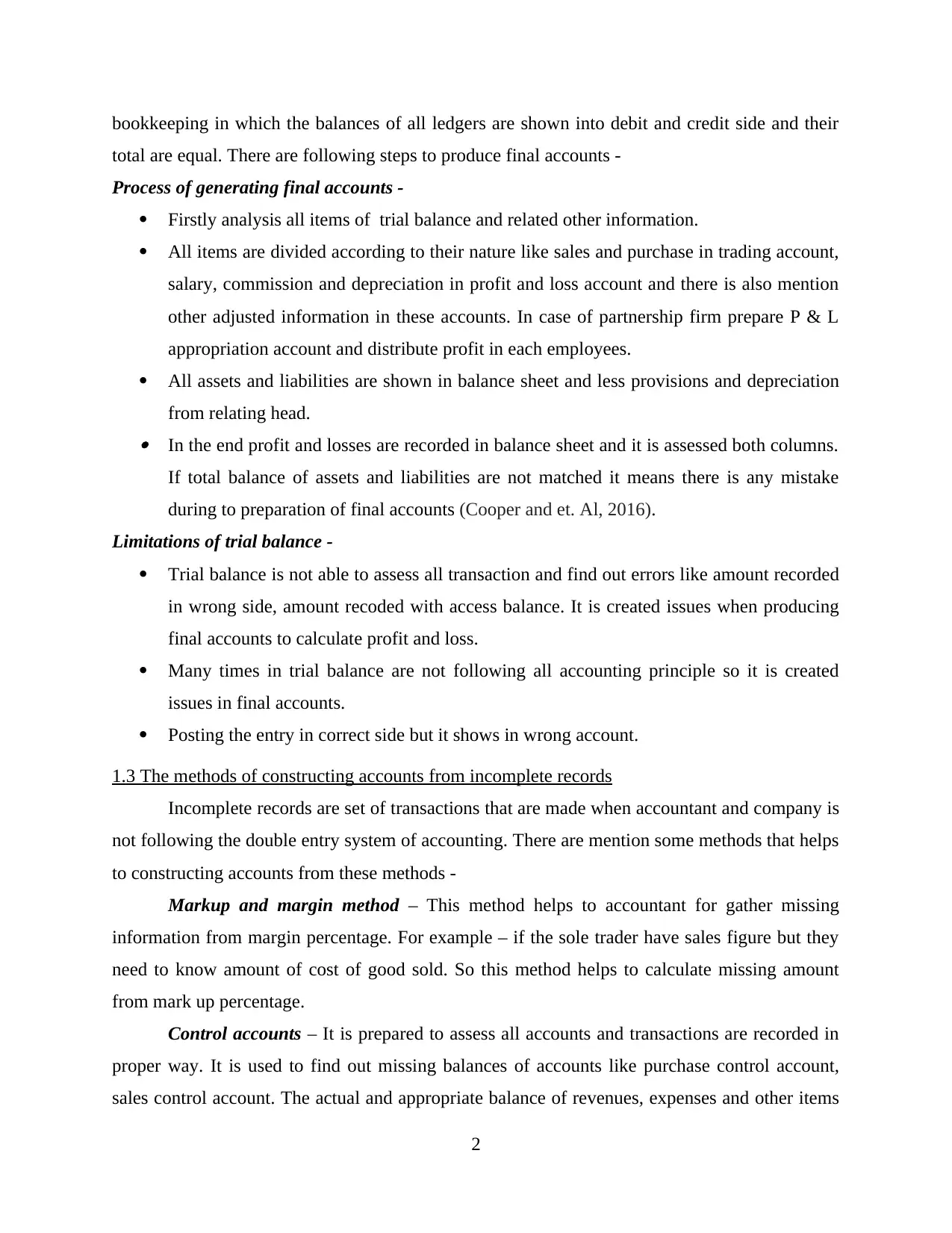
bookkeeping in which the balances of all ledgers are shown into debit and credit side and their
total are equal. There are following steps to produce final accounts -
Process of generating final accounts -
Firstly analysis all items of trial balance and related other information.
All items are divided according to their nature like sales and purchase in trading account,
salary, commission and depreciation in profit and loss account and there is also mention
other adjusted information in these accounts. In case of partnership firm prepare P & L
appropriation account and distribute profit in each employees.
All assets and liabilities are shown in balance sheet and less provisions and depreciation
from relating head. In the end profit and losses are recorded in balance sheet and it is assessed both columns.
If total balance of assets and liabilities are not matched it means there is any mistake
during to preparation of final accounts (Cooper and et. Al, 2016).
Limitations of trial balance -
Trial balance is not able to assess all transaction and find out errors like amount recorded
in wrong side, amount recoded with access balance. It is created issues when producing
final accounts to calculate profit and loss.
Many times in trial balance are not following all accounting principle so it is created
issues in final accounts.
Posting the entry in correct side but it shows in wrong account.
1.3 The methods of constructing accounts from incomplete records
Incomplete records are set of transactions that are made when accountant and company is
not following the double entry system of accounting. There are mention some methods that helps
to constructing accounts from these methods -
Markup and margin method – This method helps to accountant for gather missing
information from margin percentage. For example – if the sole trader have sales figure but they
need to know amount of cost of good sold. So this method helps to calculate missing amount
from mark up percentage.
Control accounts – It is prepared to assess all accounts and transactions are recorded in
proper way. It is used to find out missing balances of accounts like purchase control account,
sales control account. The actual and appropriate balance of revenues, expenses and other items
2
total are equal. There are following steps to produce final accounts -
Process of generating final accounts -
Firstly analysis all items of trial balance and related other information.
All items are divided according to their nature like sales and purchase in trading account,
salary, commission and depreciation in profit and loss account and there is also mention
other adjusted information in these accounts. In case of partnership firm prepare P & L
appropriation account and distribute profit in each employees.
All assets and liabilities are shown in balance sheet and less provisions and depreciation
from relating head. In the end profit and losses are recorded in balance sheet and it is assessed both columns.
If total balance of assets and liabilities are not matched it means there is any mistake
during to preparation of final accounts (Cooper and et. Al, 2016).
Limitations of trial balance -
Trial balance is not able to assess all transaction and find out errors like amount recorded
in wrong side, amount recoded with access balance. It is created issues when producing
final accounts to calculate profit and loss.
Many times in trial balance are not following all accounting principle so it is created
issues in final accounts.
Posting the entry in correct side but it shows in wrong account.
1.3 The methods of constructing accounts from incomplete records
Incomplete records are set of transactions that are made when accountant and company is
not following the double entry system of accounting. There are mention some methods that helps
to constructing accounts from these methods -
Markup and margin method – This method helps to accountant for gather missing
information from margin percentage. For example – if the sole trader have sales figure but they
need to know amount of cost of good sold. So this method helps to calculate missing amount
from mark up percentage.
Control accounts – It is prepared to assess all accounts and transactions are recorded in
proper way. It is used to find out missing balances of accounts like purchase control account,
sales control account. The actual and appropriate balance of revenues, expenses and other items
2
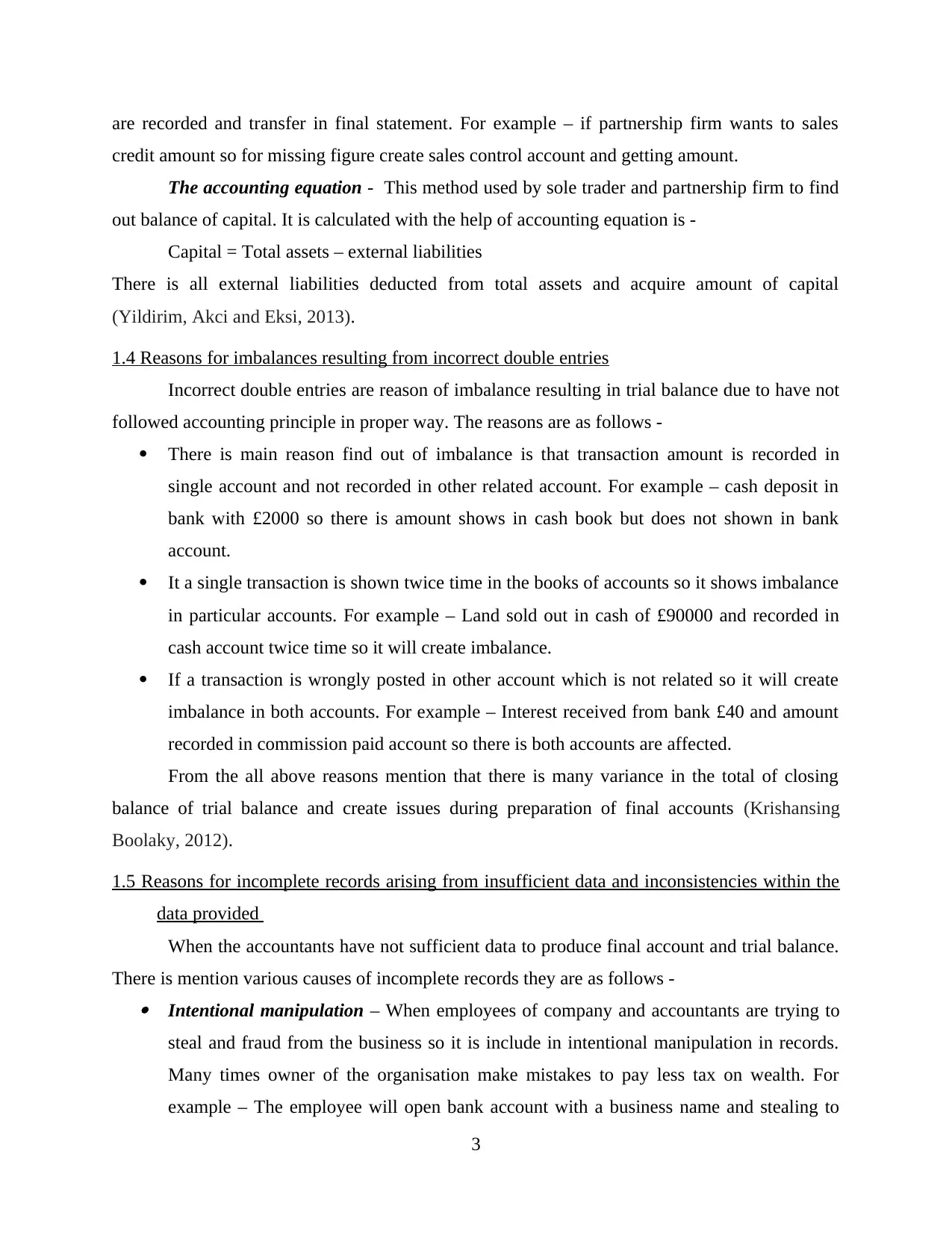
are recorded and transfer in final statement. For example – if partnership firm wants to sales
credit amount so for missing figure create sales control account and getting amount.
The accounting equation - This method used by sole trader and partnership firm to find
out balance of capital. It is calculated with the help of accounting equation is -
Capital = Total assets – external liabilities
There is all external liabilities deducted from total assets and acquire amount of capital
(Yildirim, Akci and Eksi, 2013).
1.4 Reasons for imbalances resulting from incorrect double entries
Incorrect double entries are reason of imbalance resulting in trial balance due to have not
followed accounting principle in proper way. The reasons are as follows -
There is main reason find out of imbalance is that transaction amount is recorded in
single account and not recorded in other related account. For example – cash deposit in
bank with £2000 so there is amount shows in cash book but does not shown in bank
account.
It a single transaction is shown twice time in the books of accounts so it shows imbalance
in particular accounts. For example – Land sold out in cash of £90000 and recorded in
cash account twice time so it will create imbalance.
If a transaction is wrongly posted in other account which is not related so it will create
imbalance in both accounts. For example – Interest received from bank £40 and amount
recorded in commission paid account so there is both accounts are affected.
From the all above reasons mention that there is many variance in the total of closing
balance of trial balance and create issues during preparation of final accounts (Krishansing
Boolaky, 2012).
1.5 Reasons for incomplete records arising from insufficient data and inconsistencies within the
data provided
When the accountants have not sufficient data to produce final account and trial balance.
There is mention various causes of incomplete records they are as follows - Intentional manipulation – When employees of company and accountants are trying to
steal and fraud from the business so it is include in intentional manipulation in records.
Many times owner of the organisation make mistakes to pay less tax on wealth. For
example – The employee will open bank account with a business name and stealing to
3
credit amount so for missing figure create sales control account and getting amount.
The accounting equation - This method used by sole trader and partnership firm to find
out balance of capital. It is calculated with the help of accounting equation is -
Capital = Total assets – external liabilities
There is all external liabilities deducted from total assets and acquire amount of capital
(Yildirim, Akci and Eksi, 2013).
1.4 Reasons for imbalances resulting from incorrect double entries
Incorrect double entries are reason of imbalance resulting in trial balance due to have not
followed accounting principle in proper way. The reasons are as follows -
There is main reason find out of imbalance is that transaction amount is recorded in
single account and not recorded in other related account. For example – cash deposit in
bank with £2000 so there is amount shows in cash book but does not shown in bank
account.
It a single transaction is shown twice time in the books of accounts so it shows imbalance
in particular accounts. For example – Land sold out in cash of £90000 and recorded in
cash account twice time so it will create imbalance.
If a transaction is wrongly posted in other account which is not related so it will create
imbalance in both accounts. For example – Interest received from bank £40 and amount
recorded in commission paid account so there is both accounts are affected.
From the all above reasons mention that there is many variance in the total of closing
balance of trial balance and create issues during preparation of final accounts (Krishansing
Boolaky, 2012).
1.5 Reasons for incomplete records arising from insufficient data and inconsistencies within the
data provided
When the accountants have not sufficient data to produce final account and trial balance.
There is mention various causes of incomplete records they are as follows - Intentional manipulation – When employees of company and accountants are trying to
steal and fraud from the business so it is include in intentional manipulation in records.
Many times owner of the organisation make mistakes to pay less tax on wealth. For
example – The employee will open bank account with a business name and stealing to
3
⊘ This is a preview!⊘
Do you want full access?
Subscribe today to unlock all pages.

Trusted by 1+ million students worldwide
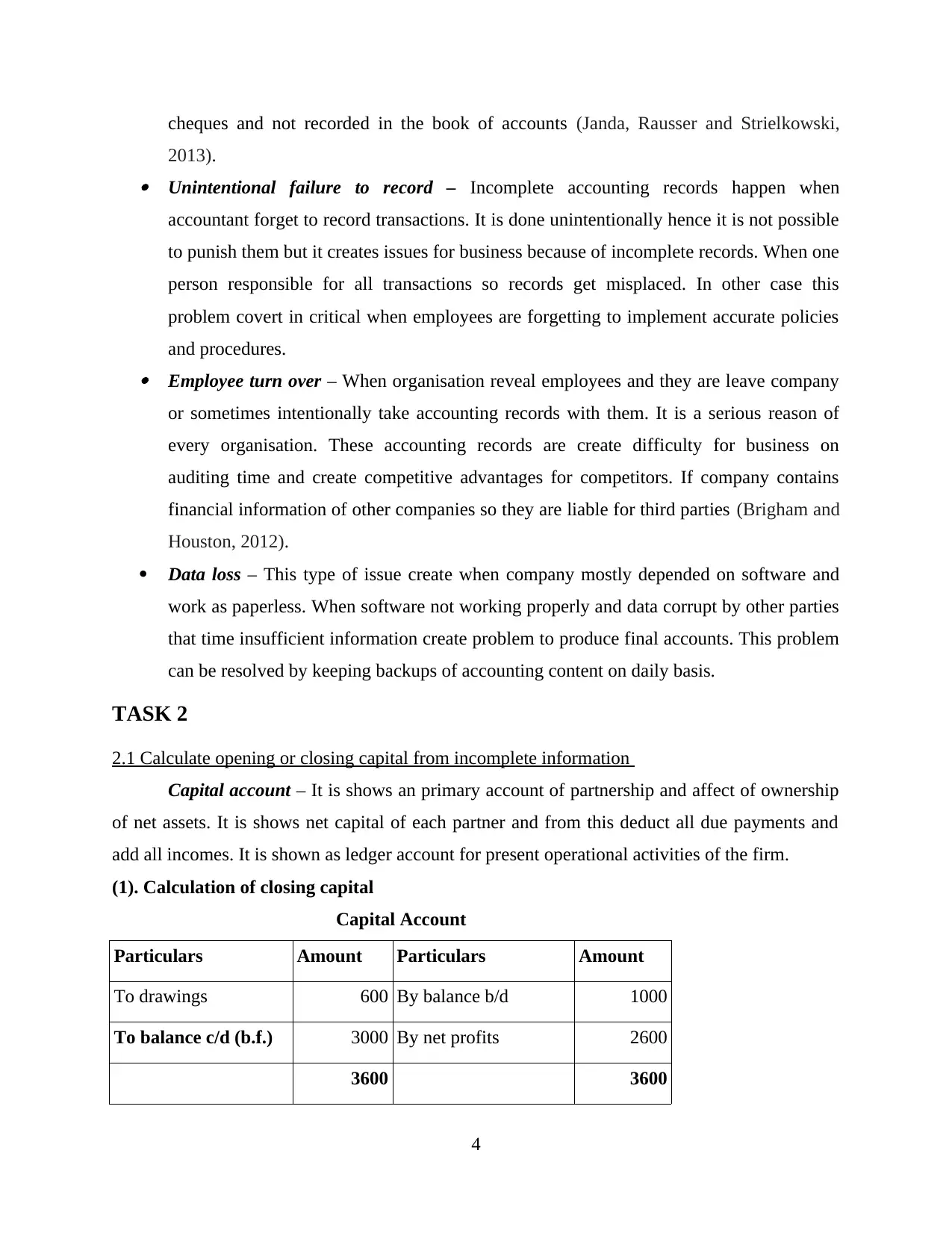
cheques and not recorded in the book of accounts (Janda, Rausser and Strielkowski,
2013). Unintentional failure to record – Incomplete accounting records happen when
accountant forget to record transactions. It is done unintentionally hence it is not possible
to punish them but it creates issues for business because of incomplete records. When one
person responsible for all transactions so records get misplaced. In other case this
problem covert in critical when employees are forgetting to implement accurate policies
and procedures. Employee turn over – When organisation reveal employees and they are leave company
or sometimes intentionally take accounting records with them. It is a serious reason of
every organisation. These accounting records are create difficulty for business on
auditing time and create competitive advantages for competitors. If company contains
financial information of other companies so they are liable for third parties (Brigham and
Houston, 2012).
Data loss – This type of issue create when company mostly depended on software and
work as paperless. When software not working properly and data corrupt by other parties
that time insufficient information create problem to produce final accounts. This problem
can be resolved by keeping backups of accounting content on daily basis.
TASK 2
2.1 Calculate opening or closing capital from incomplete information
Capital account – It is shows an primary account of partnership and affect of ownership
of net assets. It is shows net capital of each partner and from this deduct all due payments and
add all incomes. It is shown as ledger account for present operational activities of the firm.
(1). Calculation of closing capital
Capital Account
Particulars Amount Particulars Amount
To drawings 600 By balance b/d 1000
To balance c/d (b.f.) 3000 By net profits 2600
3600 3600
4
2013). Unintentional failure to record – Incomplete accounting records happen when
accountant forget to record transactions. It is done unintentionally hence it is not possible
to punish them but it creates issues for business because of incomplete records. When one
person responsible for all transactions so records get misplaced. In other case this
problem covert in critical when employees are forgetting to implement accurate policies
and procedures. Employee turn over – When organisation reveal employees and they are leave company
or sometimes intentionally take accounting records with them. It is a serious reason of
every organisation. These accounting records are create difficulty for business on
auditing time and create competitive advantages for competitors. If company contains
financial information of other companies so they are liable for third parties (Brigham and
Houston, 2012).
Data loss – This type of issue create when company mostly depended on software and
work as paperless. When software not working properly and data corrupt by other parties
that time insufficient information create problem to produce final accounts. This problem
can be resolved by keeping backups of accounting content on daily basis.
TASK 2
2.1 Calculate opening or closing capital from incomplete information
Capital account – It is shows an primary account of partnership and affect of ownership
of net assets. It is shows net capital of each partner and from this deduct all due payments and
add all incomes. It is shown as ledger account for present operational activities of the firm.
(1). Calculation of closing capital
Capital Account
Particulars Amount Particulars Amount
To drawings 600 By balance b/d 1000
To balance c/d (b.f.) 3000 By net profits 2600
3600 3600
4
Paraphrase This Document
Need a fresh take? Get an instant paraphrase of this document with our AI Paraphraser
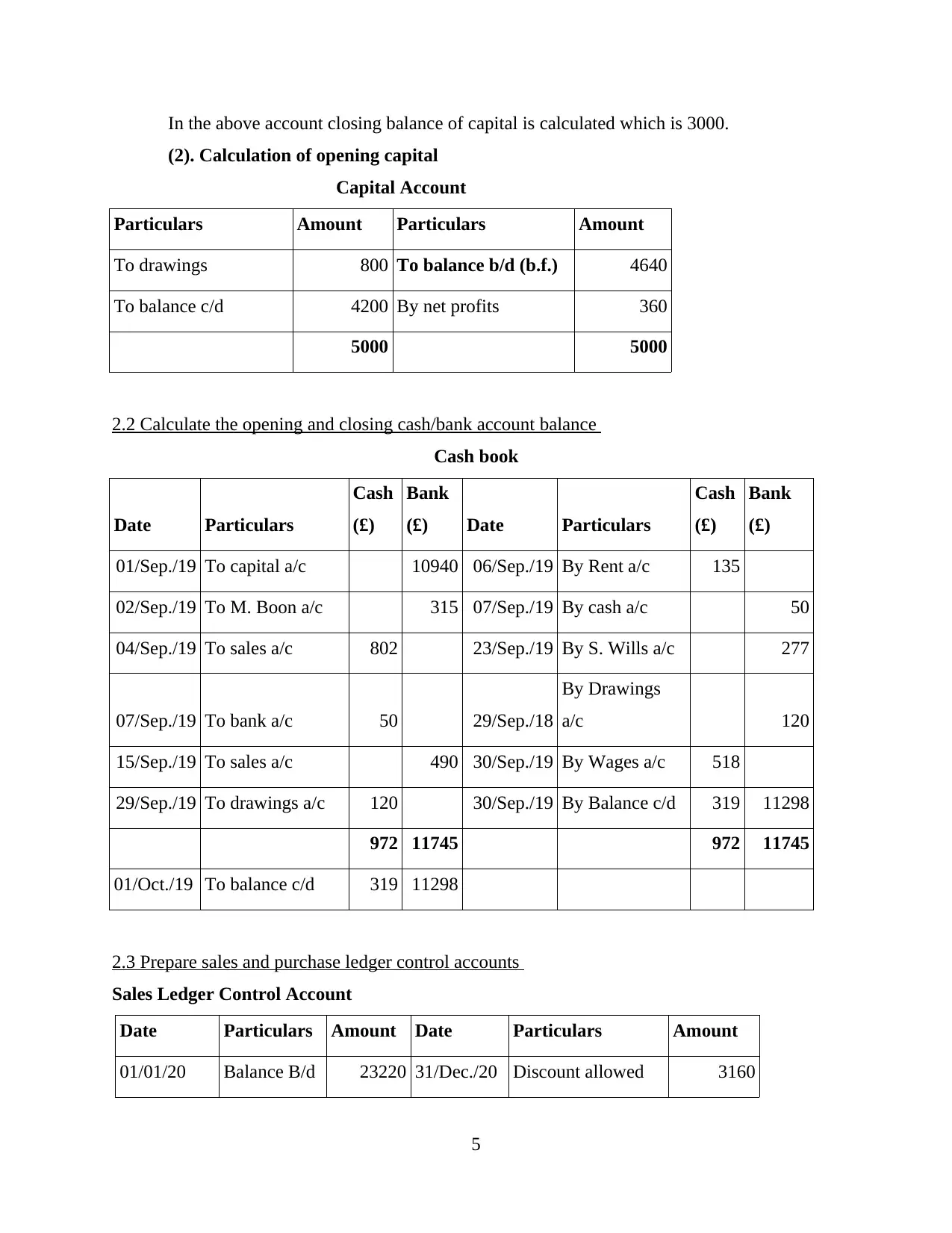
In the above account closing balance of capital is calculated which is 3000.
(2). Calculation of opening capital
Capital Account
Particulars Amount Particulars Amount
To drawings 800 To balance b/d (b.f.) 4640
To balance c/d 4200 By net profits 360
5000 5000
2.2 Calculate the opening and closing cash/bank account balance
Cash book
Date Particulars
Cash
(£)
Bank
(£) Date Particulars
Cash
(£)
Bank
(£)
01/Sep./19 To capital a/c 10940 06/Sep./19 By Rent a/c 135
02/Sep./19 To M. Boon a/c 315 07/Sep./19 By cash a/c 50
04/Sep./19 To sales a/c 802 23/Sep./19 By S. Wills a/c 277
07/Sep./19 To bank a/c 50 29/Sep./18
By Drawings
a/c 120
15/Sep./19 To sales a/c 490 30/Sep./19 By Wages a/c 518
29/Sep./19 To drawings a/c 120 30/Sep./19 By Balance c/d 319 11298
972 11745 972 11745
01/Oct./19 To balance c/d 319 11298
2.3 Prepare sales and purchase ledger control accounts
Sales Ledger Control Account
Date Particulars Amount Date Particulars Amount
01/01/20 Balance B/d 23220 31/Dec./20 Discount allowed 3160
5
(2). Calculation of opening capital
Capital Account
Particulars Amount Particulars Amount
To drawings 800 To balance b/d (b.f.) 4640
To balance c/d 4200 By net profits 360
5000 5000
2.2 Calculate the opening and closing cash/bank account balance
Cash book
Date Particulars
Cash
(£)
Bank
(£) Date Particulars
Cash
(£)
Bank
(£)
01/Sep./19 To capital a/c 10940 06/Sep./19 By Rent a/c 135
02/Sep./19 To M. Boon a/c 315 07/Sep./19 By cash a/c 50
04/Sep./19 To sales a/c 802 23/Sep./19 By S. Wills a/c 277
07/Sep./19 To bank a/c 50 29/Sep./18
By Drawings
a/c 120
15/Sep./19 To sales a/c 490 30/Sep./19 By Wages a/c 518
29/Sep./19 To drawings a/c 120 30/Sep./19 By Balance c/d 319 11298
972 11745 972 11745
01/Oct./19 To balance c/d 319 11298
2.3 Prepare sales and purchase ledger control accounts
Sales Ledger Control Account
Date Particulars Amount Date Particulars Amount
01/01/20 Balance B/d 23220 31/Dec./20 Discount allowed 3160
5
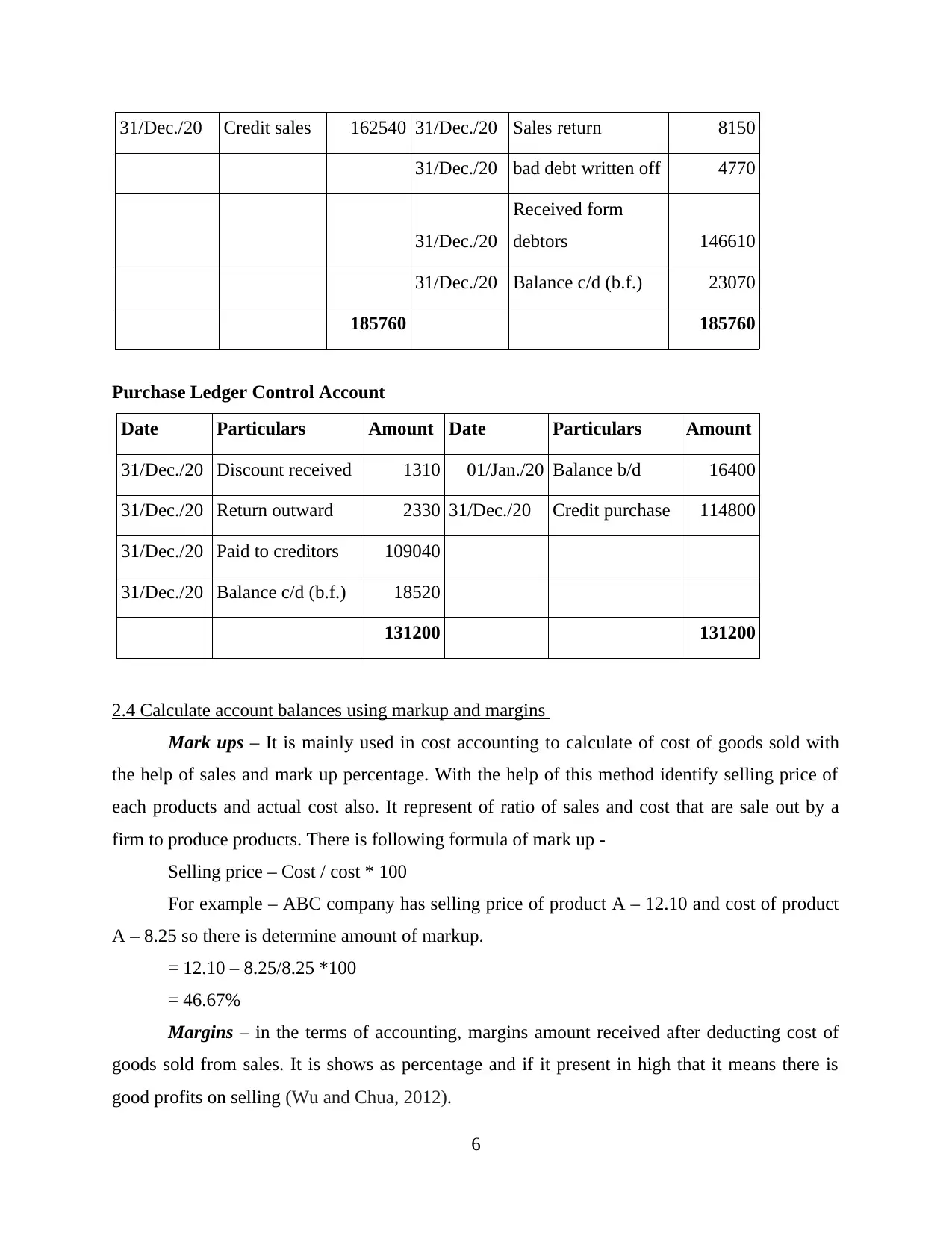
31/Dec./20 Credit sales 162540 31/Dec./20 Sales return 8150
31/Dec./20 bad debt written off 4770
31/Dec./20
Received form
debtors 146610
31/Dec./20 Balance c/d (b.f.) 23070
185760 185760
Purchase Ledger Control Account
Date Particulars Amount Date Particulars Amount
31/Dec./20 Discount received 1310 01/Jan./20 Balance b/d 16400
31/Dec./20 Return outward 2330 31/Dec./20 Credit purchase 114800
31/Dec./20 Paid to creditors 109040
31/Dec./20 Balance c/d (b.f.) 18520
131200 131200
2.4 Calculate account balances using markup and margins
Mark ups – It is mainly used in cost accounting to calculate of cost of goods sold with
the help of sales and mark up percentage. With the help of this method identify selling price of
each products and actual cost also. It represent of ratio of sales and cost that are sale out by a
firm to produce products. There is following formula of mark up -
Selling price – Cost / cost * 100
For example – ABC company has selling price of product A – 12.10 and cost of product
A – 8.25 so there is determine amount of markup.
= 12.10 – 8.25/8.25 *100
= 46.67%
Margins – in the terms of accounting, margins amount received after deducting cost of
goods sold from sales. It is shows as percentage and if it present in high that it means there is
good profits on selling (Wu and Chua, 2012).
6
31/Dec./20 bad debt written off 4770
31/Dec./20
Received form
debtors 146610
31/Dec./20 Balance c/d (b.f.) 23070
185760 185760
Purchase Ledger Control Account
Date Particulars Amount Date Particulars Amount
31/Dec./20 Discount received 1310 01/Jan./20 Balance b/d 16400
31/Dec./20 Return outward 2330 31/Dec./20 Credit purchase 114800
31/Dec./20 Paid to creditors 109040
31/Dec./20 Balance c/d (b.f.) 18520
131200 131200
2.4 Calculate account balances using markup and margins
Mark ups – It is mainly used in cost accounting to calculate of cost of goods sold with
the help of sales and mark up percentage. With the help of this method identify selling price of
each products and actual cost also. It represent of ratio of sales and cost that are sale out by a
firm to produce products. There is following formula of mark up -
Selling price – Cost / cost * 100
For example – ABC company has selling price of product A – 12.10 and cost of product
A – 8.25 so there is determine amount of markup.
= 12.10 – 8.25/8.25 *100
= 46.67%
Margins – in the terms of accounting, margins amount received after deducting cost of
goods sold from sales. It is shows as percentage and if it present in high that it means there is
good profits on selling (Wu and Chua, 2012).
6
⊘ This is a preview!⊘
Do you want full access?
Subscribe today to unlock all pages.

Trusted by 1+ million students worldwide
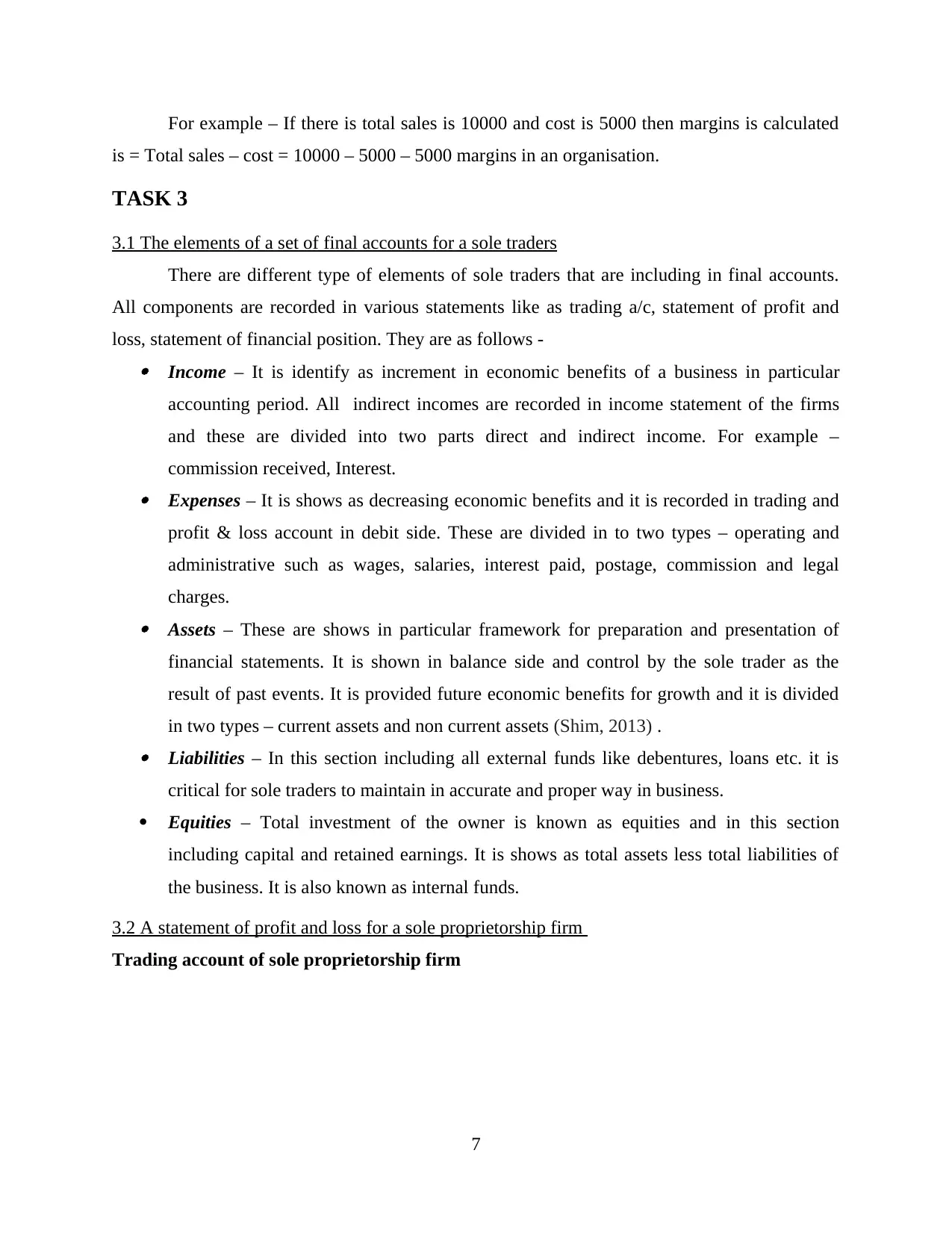
For example – If there is total sales is 10000 and cost is 5000 then margins is calculated
is = Total sales – cost = 10000 – 5000 – 5000 margins in an organisation.
TASK 3
3.1 The elements of a set of final accounts for a sole traders
There are different type of elements of sole traders that are including in final accounts.
All components are recorded in various statements like as trading a/c, statement of profit and
loss, statement of financial position. They are as follows - Income – It is identify as increment in economic benefits of a business in particular
accounting period. All indirect incomes are recorded in income statement of the firms
and these are divided into two parts direct and indirect income. For example –
commission received, Interest. Expenses – It is shows as decreasing economic benefits and it is recorded in trading and
profit & loss account in debit side. These are divided in to two types – operating and
administrative such as wages, salaries, interest paid, postage, commission and legal
charges. Assets – These are shows in particular framework for preparation and presentation of
financial statements. It is shown in balance side and control by the sole trader as the
result of past events. It is provided future economic benefits for growth and it is divided
in two types – current assets and non current assets (Shim, 2013) . Liabilities – In this section including all external funds like debentures, loans etc. it is
critical for sole traders to maintain in accurate and proper way in business.
Equities – Total investment of the owner is known as equities and in this section
including capital and retained earnings. It is shows as total assets less total liabilities of
the business. It is also known as internal funds.
3.2 A statement of profit and loss for a sole proprietorship firm
Trading account of sole proprietorship firm
7
is = Total sales – cost = 10000 – 5000 – 5000 margins in an organisation.
TASK 3
3.1 The elements of a set of final accounts for a sole traders
There are different type of elements of sole traders that are including in final accounts.
All components are recorded in various statements like as trading a/c, statement of profit and
loss, statement of financial position. They are as follows - Income – It is identify as increment in economic benefits of a business in particular
accounting period. All indirect incomes are recorded in income statement of the firms
and these are divided into two parts direct and indirect income. For example –
commission received, Interest. Expenses – It is shows as decreasing economic benefits and it is recorded in trading and
profit & loss account in debit side. These are divided in to two types – operating and
administrative such as wages, salaries, interest paid, postage, commission and legal
charges. Assets – These are shows in particular framework for preparation and presentation of
financial statements. It is shown in balance side and control by the sole trader as the
result of past events. It is provided future economic benefits for growth and it is divided
in two types – current assets and non current assets (Shim, 2013) . Liabilities – In this section including all external funds like debentures, loans etc. it is
critical for sole traders to maintain in accurate and proper way in business.
Equities – Total investment of the owner is known as equities and in this section
including capital and retained earnings. It is shows as total assets less total liabilities of
the business. It is also known as internal funds.
3.2 A statement of profit and loss for a sole proprietorship firm
Trading account of sole proprietorship firm
7
Paraphrase This Document
Need a fresh take? Get an instant paraphrase of this document with our AI Paraphraser
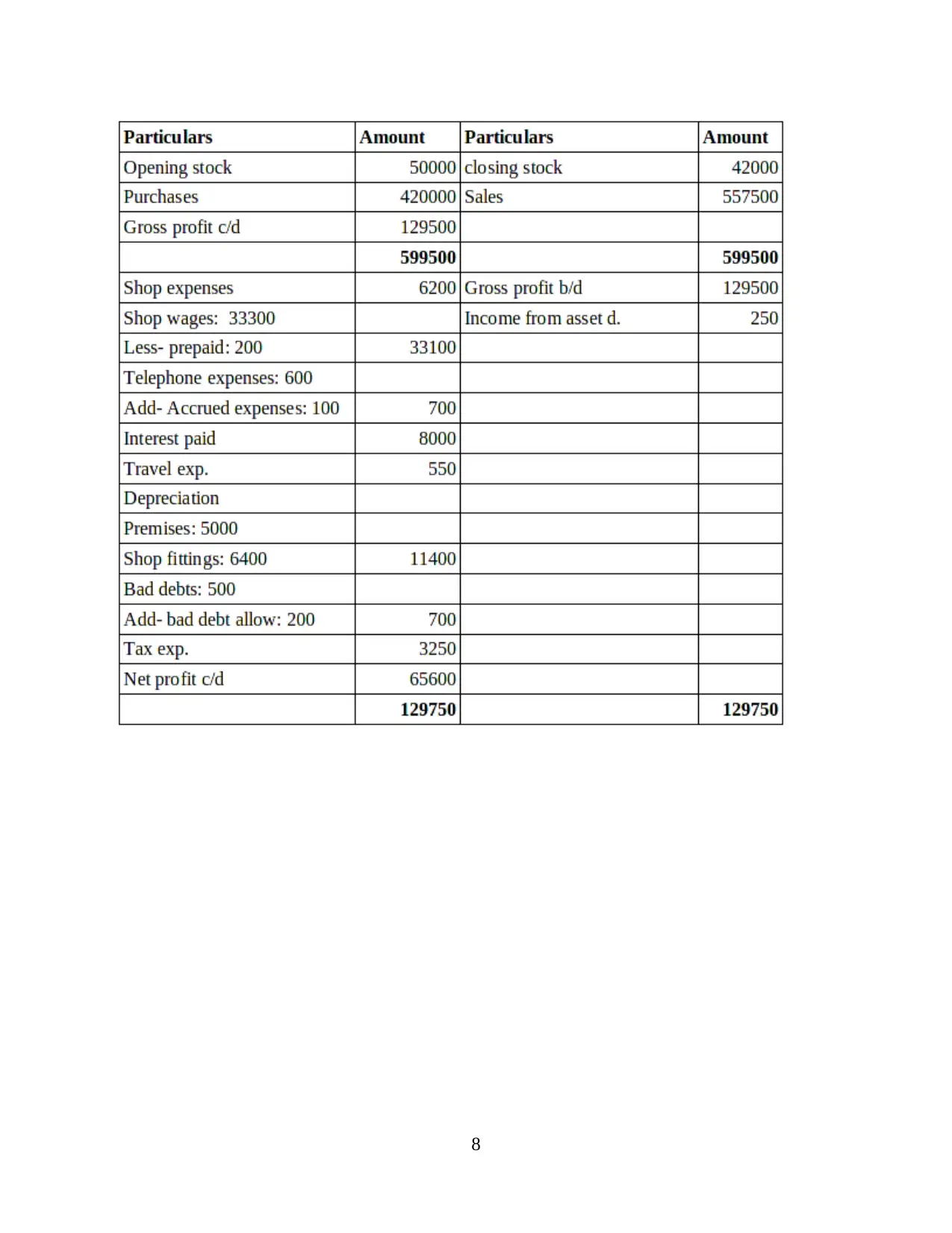
8
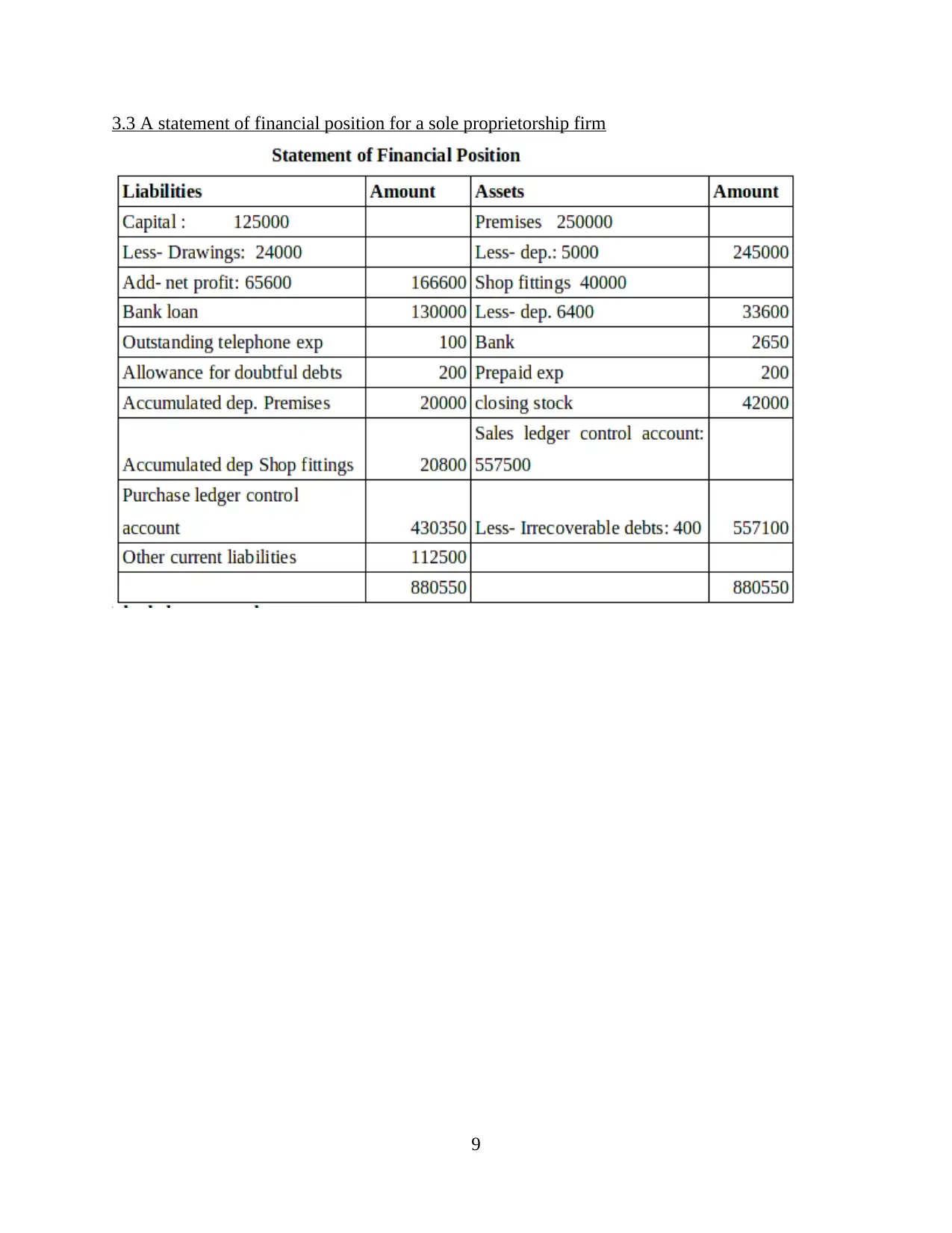
3.3 A statement of financial position for a sole proprietorship firm
9
9
⊘ This is a preview!⊘
Do you want full access?
Subscribe today to unlock all pages.

Trusted by 1+ million students worldwide
1 out of 20
Related Documents
Your All-in-One AI-Powered Toolkit for Academic Success.
+13062052269
info@desklib.com
Available 24*7 on WhatsApp / Email
![[object Object]](/_next/static/media/star-bottom.7253800d.svg)
Unlock your academic potential
Copyright © 2020–2025 A2Z Services. All Rights Reserved. Developed and managed by ZUCOL.





